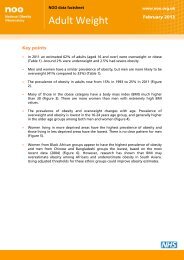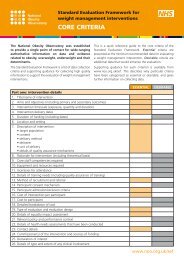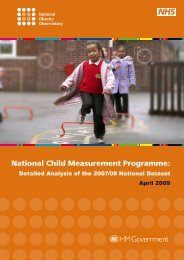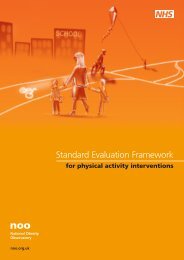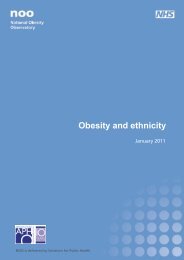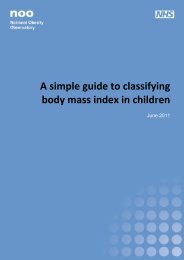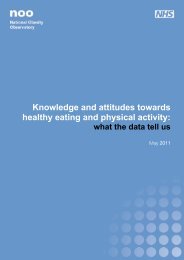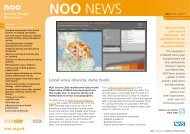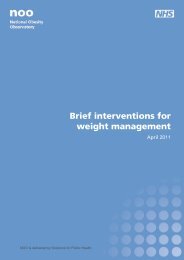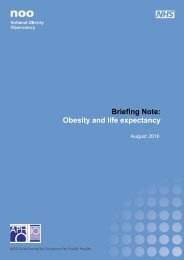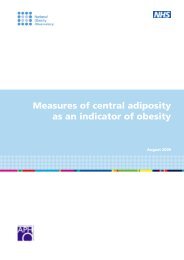Review of dietary assessment methods in public health - National ...
Review of dietary assessment methods in public health - National ...
Review of dietary assessment methods in public health - National ...
You also want an ePaper? Increase the reach of your titles
YUMPU automatically turns print PDFs into web optimized ePapers that Google loves.
Day <strong>in</strong> the Life QuestionnaireThe Day <strong>in</strong> the Life Questionnaire (DILQ) 5 was developed as a supervised classroomexercise to measure fruit and vegetable consumption dur<strong>in</strong>g the previous day amongchildren aged 7–9 years.OverviewThis questionnaire uses the 24 hour recall method to measure consumption and uses amixture <strong>of</strong> words and pictures to ga<strong>in</strong> <strong>in</strong>formation. For example, the child must drawtheir breakfast <strong>in</strong> a pre-drawn circle and list all food items that were <strong>in</strong> their breakfast.The aim <strong>of</strong> these pictures is to aid recollection by the child and improve completion <strong>of</strong>the tool. It takes the child through their previous day and gets them to write downeveryth<strong>in</strong>g that happened. The tool does not focus specifically on fruit and vegetable<strong>in</strong>take, but on all activities <strong>in</strong> a s<strong>in</strong>gle day.It is important to note that the questionnaire does not measure fruit and vegetablesconta<strong>in</strong>ed <strong>in</strong> composite foods, such as pizzas and pies. The explanation for this is that itwould be too difficult to estimate their contribution to the diet. Nor does thequestionnaire measure dr<strong>in</strong>ks because it is difficult to determ<strong>in</strong>e whether the dr<strong>in</strong>ks arepure fruit juice or diluted.The time needed to complete the questionnaire will vary depend<strong>in</strong>g on the child’sability and what the child actually ate the day before. It is generally undertaken <strong>in</strong> theclassroom under supervision with the researcher guid<strong>in</strong>g the children through thequestions. The children fill <strong>in</strong> the questionnaires themselves, but are allowed to speakwith one another and ask for help from additional researchers or teachers. The use <strong>of</strong>additional researchers for this purpose would <strong>in</strong>crease the resources and fund<strong>in</strong>grequired for application <strong>of</strong> the questionnaire. Dur<strong>in</strong>g test<strong>in</strong>g it typically took 30–40m<strong>in</strong>utes for each class to complete the entire questionnaire. Some children completedthe questionnaire more quickly than others, and these children were encouraged todraw further pictures or to colour the pictures already drawn. This was reported asbe<strong>in</strong>g quite useful with this age group as these children did not distract others stillcomplet<strong>in</strong>g the questionnaire. Most children enjoyed complet<strong>in</strong>g the questionnaireand most teachers found it to be appropriate for use <strong>in</strong> this age group.Validation and reliabilityThe authors state that there was no gold standard method available to test the validity<strong>of</strong> the questionnaire, but an observation method was used. Individuals were tra<strong>in</strong>ed toobserve the food eaten by children throughout the school day <strong>in</strong> two city-based schoolsand two village-based schools. Their reports were then compared to the completedquestionnaires. There appeared to be relatively good agreement between DILQ scoresand observations, with 70% agreement reported by the authors. In addition, <strong>in</strong>terraterreliability was reported to be high with levels rang<strong>in</strong>g from 0.85 for fruit and 0.92for vegetables. No value was provided for total consumption.Four schools were <strong>in</strong>volved <strong>in</strong> the test<strong>in</strong>g <strong>of</strong> the questionnaire. The questionnaire wasadm<strong>in</strong>istered on two occasions two weeks apart to assess test-retest reliability. Meandaily fruit and vegetable consumption was compared for each adm<strong>in</strong>istration for eachschool. No significant differences were reported for three out <strong>of</strong> the four schools. In theschool where a difference was detected, it was noted that no vegetables were providedfor school lunch on that day which is likely to account for the differences.NOO | <strong>Review</strong> <strong>of</strong> <strong>dietary</strong> <strong>assessment</strong> <strong>methods</strong> <strong>in</strong> <strong>public</strong> <strong>health</strong> 11



